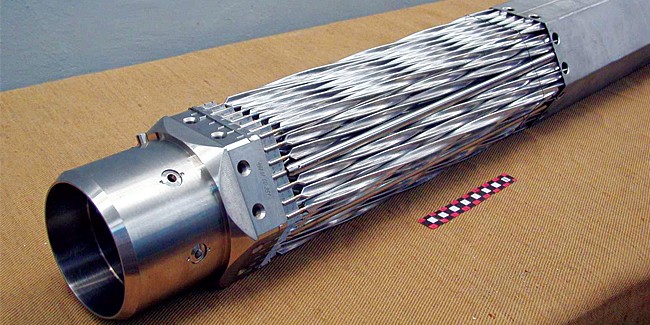This New Fuel Could Make Nuclear Power Safer and Cheaper
With 65 reactors under construction worldwide and another 173 planned, the nuclear power industry is placing bets that its long-awaited renaissance is near. But making existing and new nuclear plants more economical continues to be the biggest challenge.
One way to help meet the challenge is to make reactors’ fuel rods safer and more efficient. Lightbridge, a company in Reston, Virginia, that has been working on new fuel technologies for a quarter-century, has unveiled a metallic fuel for nuclear reactors that it says will do just that.
The fuel rods made by Lightbridge differ from today’s in several ways. Rather than a ceramic oxide of uranium, they’re made of a uranium-zirconium alloy that transports heat more easily. And rather than a tube that contains cylindrical uranium pellets, each one is a single piece of metal, ridged like a piece of licorice and spiraling in a helix. This shape allows more water to flow across the rod’s surface, transferring more heat and thus increasing electricity generation. The bigger surface area also increases the safety margin of the reactor core, allowing the rods to sustain nuclear reactions at much lower temperatures: their internal temperature during operation is around 360 °C, nearly 900 degrees cooler than conventional rods.

The result, says Lightbridge CEO Seth Grae, is a more powerful, safer, and more cost-effective reactor that can help reduce emissions of greenhouse gases within the next several years. “Renewables alone will not get us there from here in terms of meeting our climate goals in time,” says Grae. “New types of reactors will not get us there in time. The increased use of today’s reactors and new [conventional] reactors is a necessary component of any successful path to meeting climate goals.”
Earlier this year Lightbridge agreed to work with French nuclear giant Areva to commercialize the new fuel rods, which could be installed in existing and newly built reactors as early as 2020, Grae says. The technology could increase the power of existing reactors by 10 percent while extending the operating time between refuelings (a key economic indicator for nuclear plants) from 18 months to 24. Replacing the conventional rods in an existing reactor would add $60 million in annual revenue for a 1,100-megawatt reactor, the company says.
The new fuel is “a major improvement over conventional oxide fuel for [conventional] reactors,” says Per Peterson, a professor of nuclear engineering at the University of California, Berkeley, who heads a team developing an advanced reactor design. “The capability of the Lightbridge fuel to run at much lower temperature than conventional oxide fuel does have major safety benefits.”
The safety question, however, is complicated, according to Ian Scott, a cofounder of Moltex Energy, a company based in the United Kingdom that’s developing an advanced liquid-fuel reactor. The high heat transfer capability of the solid fuel means the rods would cool down faster in the event of a temporary loss of coolant. But the melting point of the Lightbridge rods is much lower than that of uranium oxide fuel, meaning that in a total, Fukushima-style accident, disaster could ensue much sooner.
“There is a big push at the moment to create ‘accident-tolerant’ fuels for [conventional] reactors,” says Scott. “These are fuels that are more tolerant of very high temperatures in a ‘beyond design-basis’ accident than uranium oxide. The Lightbridge fuel goes in the opposite direction.”
How exactly regulators at the Nuclear Regulatory Commission will view the safety and economic benefits of the new fuel remains to be seen. But there is no question that existing reactors, and newly built ones of conventional design, are ripe for innovative fuel technology.
“Using this fuel in new builds will help improve nuclear’s economics, which will be very helpful for the industry as a whole,” says Leslie Dewan, the cofounder of Transatomic Power, which is working on a design for an advanced liquid-fuel reactor. “I think the biggest unknown is the amount of time it’ll take to certify the new fuel.”
Keep Reading
Most Popular
Large language models can do jaw-dropping things. But nobody knows exactly why.
And that's a problem. Figuring it out is one of the biggest scientific puzzles of our time and a crucial step towards controlling more powerful future models.
The problem with plug-in hybrids? Their drivers.
Plug-in hybrids are often sold as a transition to EVs, but new data from Europe shows we’re still underestimating the emissions they produce.
How scientists traced a mysterious covid case back to six toilets
When wastewater surveillance turns into a hunt for a single infected individual, the ethics get tricky.
Google DeepMind’s new generative model makes Super Mario–like games from scratch
Genie learns how to control games by watching hours and hours of video. It could help train next-gen robots too.
Stay connected
Get the latest updates from
MIT Technology Review
Discover special offers, top stories, upcoming events, and more.